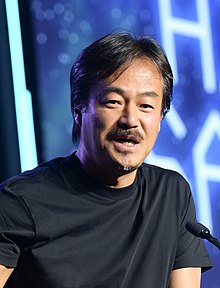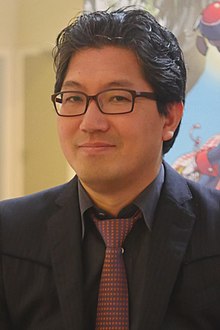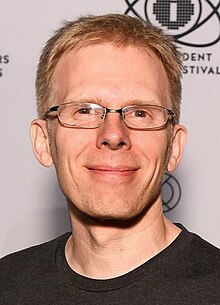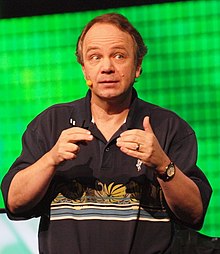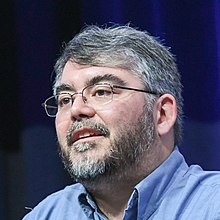Portal:Video games
Portal maintenance status: (April 2019)
|
The Video Games Portal

A video game, also known as a computer game or just a game, is an electronic game that involves interaction with a user interface or input device (such as a joystick, controller, keyboard, or motion sensing device) to generate visual feedback from a display device, most commonly shown in a video format on a television set, computer monitor, flat-panel display or touchscreen on handheld devices, or a virtual reality headset. Most modern video games are audiovisual, with audio complement delivered through speakers or headphones, and sometimes also with other types of sensory feedback (e.g., haptic technology that provides tactile sensations). Some video games also allow microphone and webcam inputs for in-game chatting and livestreaming.
Video games are typically categorized according to their hardware platform, which traditionally includes arcade video games, console games, and computer (PC) games; the latter also encompasses LAN games, online games, and browser games. More recently, the video game industry has expanded onto mobile gaming through mobile devices (such as smartphones and tablet computers), virtual and augmented reality systems, and remote cloud gaming. Video games are also classified into a wide range of genres based on their style of gameplay and target audience. (Full article...)
Featured articles – load new batch
-
Image 1Pathways into Darkness is a first-person shooter adventure video game developed and published by Bungie in 1993, for Macintosh personal computers. Players assume the role of a Special Forces soldier who must stop a powerful, godlike being from awakening and destroying the world. Players solve puzzles and defeat enemies to unlock parts of a pyramid where the god sleeps; the game's ending changes depending on player actions.
Pathways began as a sequel to Bungie's Minotaur: The Labyrinths of Crete, before the developers created an original story. Jason Jones programmed the game, while his friend Colin Brent developed the environments and creatures. The game features three-dimensional, texture-mapped graphics and stereo sound on supported Macintosh models. Pathways was critically acclaimed and won a host of awards; it was also Bungie's first major commercial success and enabled the two-man team of Jason Jones and Alex Seropian to move into a Chicago office and begin paying staff. (Full article...) -
Image 2Super Columbine Massacre RPG! is a role-playing video game created by Danny Ledonne and released in April 2005. The game recreates the 1999 Columbine High School shootings in Columbine, Colorado. Players assume the roles of gunmen Eric Harris and Dylan Klebold and act out the massacre, with flashbacks relating parts of Harris and Klebold's past experiences. The game begins on the day of the shootings and follows Harris and Klebold after their suicides to fictional adventures in perdition.
Ledonne had spent many years conceptualizing games, but never created one due to his lack of game design and programming knowledge. He was inspired to create a video game about Columbine by his own experience being bullied and the effect the shooting had on his life. The game represents a critique of how traditional media sensationalized the shooting, as well as parodying video games themselves. Super Columbine Massacre was created with ASCII's game development program RPG Maker 2000 and took approximately six months to complete. Ledonne initially published the game anonymously, releasing an artist's statement about the work after his identity was revealed. Super Columbine Massacre was released for free online and attracted little attention until 2006, when widespread media coverage fueled hundreds of thousands of downloads.
Reaction to Super Columbine Massacre was negative; the title was criticized as trivializing the actions of Harris and Klebold and the lives of the innocent. The game's cartoon presentation and the side-plot into hell were considered by critics as obscuring the game's message, but it received minor note as a game that transcended the stereotypical associations of the medium as entertainment for children. Super Columbine Massacre's themes and content led to it being included in discussions as to whether video games cause violence; the title was later listed as one of the possible motivating factors of the shooter after the 2006 Dawson College shooting. The game has been described as an art game, and Ledonne has become a spokesperson for video games as an art form, producing a documentary in 2008 called Playing Columbine about his game and its impact. (Full article...) -
Image 3Final Fantasy VII is a 1997 role-playing video game developed by Square for the PlayStation. The seventh main installment in the Final Fantasy series, it was released in Japan by Square and internationally by Sony Computer Entertainment, becoming the first game in the main series to have a PAL release. The game's story follows Cloud Strife, a mercenary who joins an eco-terrorist organization to stop a world-controlling megacorporation from using the planet's life essence as an energy source. Ensuing events send Cloud and his allies in pursuit of Sephiroth, a superhuman who seeks to wound the planet and harness its healing power in order to be reborn as a god. Throughout their journey, Cloud bonds with his party members, including Aerith Gainsborough, who holds the secret to saving their world.
Development began in 1994, originally for the Super Nintendo Entertainment System. After delays and technical difficulties from experimenting with several platforms, most notably the Nintendo 64, Square moved production to the PlayStation, largely due to the advantages of the CD-ROM format. Veteran Final Fantasy staff returned, including series creator and producer Hironobu Sakaguchi, director Yoshinori Kitase, and composer Nobuo Uematsu. The title was the first in the series to use full motion video and 3D computer graphics, featuring 3D character models superimposed over 2D pre-rendered backgrounds. Although the gameplay remained mostly unchanged from previous entries, Final Fantasy VII introduced more widespread science fiction elements and a more realistic presentation. The combined development and marketing budget amounted to approximately US$80 million.
Final Fantasy VII received widespread commercial and critical success. It remains widely regarded as a landmark title and one of the greatest and most influential video games ever made. The title won numerous Game of the Year awards and was acknowledged for boosting the sales of the PlayStation and popularizing Japanese role-playing games worldwide. Critics praised its graphics, gameplay, music, and story, although some criticism was directed towards the original English localization. Its success has led to enhanced ports on various platforms, a multimedia subseries called the Compilation of Final Fantasy VII, and a high definition remake trilogy currently comprising Final Fantasy VII Remake (2020), and Final Fantasy VII Rebirth (2024). (Full article...) -
Image 4The Dark Pictures Anthology: House of Ashes is a 2021 interactive drama and survival horror video game developed by Supermassive Games and published by Bandai Namco Entertainment. It is the third game of the first season of The Dark Pictures Anthology. The game features a multilinear plot in which decisions can significantly alter the trajectory of the story and change the relationships between the five playable protagonists; some lead to their permanent deaths. House of Ashes is set during the 2003 invasion of Iraq and follows five characters—four Americans working for the US Armed Forces and one Iraqi Republican Guard—who must escape from an underground Akkadian temple and survive the vampiric creatures that infest the area. Ashley Tisdale, who plays CIA operative Rachel King, was marketed as the game's leading actress. Jason Graves, a long-time collaborator with Supermassive for the series, composed the soundtrack during COVID-19 lockdowns in the United Kingdom.
Reappearing in House of Ashes are staple mechanics of The Dark Pictures Anthology, such as quick time events (QTEs), two single-player and two multiplayer modes, and collectibles that allow players to see visions of possible future events. New features include a more interactive camera system, a handheld light source for easier navigation, and three difficulty levels to manage QTEs. The films Aliens, Predator, and The Descent, as well as the H. P. Lovecraft novella At the Mountains of Madness and the myth of the Curse of Akkad were the main influences for the game. The creatures were made using motion capture and hand animation, and the temple's design was inspired by ancient Mesopotamian architecture. Military specialists and Arabic speakers were consulted to ensure a faithful depiction of the war.
House of Ashes was released for PlayStation 4, PlayStation 5, Windows, Xbox One, and Xbox Series X/S on 22 October 2021, to mixed reviews. Several critics deemed it an improvement from the previous two instalments in the anthology, and points of praise included the replay value, QTE intensity, cinematography, multiplayer modes, and likeability of the Iraqi character. Critiques were directed towards the game's pacing, scare factor, facial animations, texture and animation glitches, and handling of the Iraq War. The fourth game in the series and the season one finale, The Devil in Me, was revealed in a teaser trailer at the end of House of Ashes and released on 18 November 2022. (Full article...) -
Image 5Halo: Combat Evolved Anniversary is a 2011 first-person shooter video game developed by 343 Industries, Saber Interactive, and Certain Affinity, and published by Microsoft Game Studios for the Xbox 360 console. It is a remaster of the 2001 game Halo: Combat Evolved, originally developed by Bungie. Announced at the Electronic Entertainment Expo in 2011, it was released on November 15, 2011, the tenth anniversary of Combat Evolved and the original Xbox it released on. Anniversary was later included as part of Halo: The Master Chief Collection for Xbox One in 2014, and for Windows and Xbox Series X/S in 2020.
343 Industries, an internal studio established by Microsoft in 2007, was given control over the Halo franchise after the release of Bungie's final entry, Halo: Reach in 2010. 343 Industries approached Saber Interactive to develop a remaster of Combat Evolved for the game's tenth anniversary. Saber used its proprietary game engine to reproduce the graphics and the original Halo engine for gameplay. A development tool for toggling between the old and new visuals for comparison became a feature in the shipping game. Anniversary's enhancements include a complete high-definition visual overhaul, support for cooperative and multiplayer gameplay via the Xbox Live online service, new and remastered sound effects and music, and extras such as achievements, in-game collectibles, and Kinect support.
Critical reception to Anniversary was generally positive. The updated graphics, sounds, and ability to toggle between the remastered and original visuals were praised. Complaints included technical glitches, faults with the original game's level design, and the multiplayer implementation. (Full article...) -
Image 6The Legend of Zelda: Ocarina of Time is a 1998 action-adventure game by Nintendo for the Nintendo 64. It was released in Japan and North America in November 1998 and in PAL regions the following month. The game is the first in The Legend of Zelda series with 3D graphics.
Ocarina of Time was developed by Nintendo's Entertainment Analysis & Development division. It was led by five directors, including Eiji Aonuma and Yoshiaki Koizumi, produced by series co-creator Shigeru Miyamoto, and written by Kensuke Tanabe. Series composer Koji Kondo wrote its soundtrack. The player controls Link in the realm of Hyrule on a quest to stop the evil king Ganondorf by traveling through time and navigating dungeons and an overworld. The game introduced features such as a target-lock system and context-sensitive buttons, which have since become common in 3D adventure games. The player must play songs on an ocarina to progress.
Ocarina of Time was acclaimed by critics and consumers, who praised its visuals, sound, gameplay, soundtrack, and writing. It has been ranked by numerous publications as the greatest video game of all time and is the highest-rated game on the review aggregator Metacritic. It was commercially successful, with more than seven million copies sold worldwide. In the United States, it received more than three times more pre-orders than any other game at the time. A sequel, The Legend of Zelda: Majora's Mask, was released in 2000. Ocarina of Time has been re-released on every one of Nintendo's home consoles and on the iQue Player in China. An enhanced version of the game for the Nintendo 3DS, The Legend of Zelda: Ocarina of Time 3D, was released in 2011. Master Quest, an alternative version of the game including new puzzles and increased difficulty, is included in one of the GameCube releases and the 3D version. (Full article...) -
Image 7Donkey Kong Land is a 1995 platform game developed by Rare and published by Nintendo for the Game Boy. It condenses the side-scrolling gameplay of the Super Nintendo Entertainment System (SNES) game Donkey Kong Country (1994) for the handheld Game Boy with different level design and boss fights. The player controls the gorilla Donkey Kong and his nephew Diddy Kong as they defeat enemies and collect items across 30 levels to recover their stolen banana hoard from the crocodile King K. Rool.
Development began in 1994, before Donkey Kong Country's completion, and lasted a year. Rare's Game Boy programmer, Paul Machacek, developed Land as an original game rather than as a port of Country after convincing Rare co-founder Tim Stamper it would be a better use of resources. Like Country, Land features pre-rendered graphics converted to sprites through a compression technique. Rare retooled Country's gameplay to account for the lower quality display, and David Wise and Graeme Norgate converted the soundtrack to the Game Boy's sound chip.
Donkey Kong Land was released in mid-1995. It sold 3.91 million copies and received positive reviews. Critics praised it as successfully translating Country's gameplay, visuals, and music to the Game Boy, though they disagreed over whether it was an equal experience. Land was followed by Donkey Kong Land 2 (1996), Donkey Kong Land III (1997), and a Game Boy Color version of Country (2000), which attempted to replicate the SNES Country games more closely. Land and its sequels were rereleased for the Nintendo 3DS via the Virtual Console service in 2014. (Full article...) -
Image 8Conan is a 2007 action-adventure game developed by Nihilistic Software and published by THQ for the PlayStation 3 and Xbox 360. Players take control of the titular hero, Conan the Barbarian, from Robert E. Howard's fantasy literature.
In Conan, the hero is on a quest to recover his lost armor and defeat an evil wizard. Conan can fight with sword and shield, two-handed weapons, or a weapon in each hand. Starting with several basic attacks, the barbarian gains experience points by killing enemies. By exchanging these points for additional attacks, players improve the hero's fighting abilities. Magic powers complement Conan's arsenal, including the abilities to turn enemies into stone and conjure firestorms. The game also features context-sensitive action sequences in which players press a sequence of buttons displayed on the screen to complete actions such as killing powerful enemies and interacting with the environment.
Critics enjoyed Conan's combat system and gory kills, but said the game failed to match the experience offered in God of War. Reactions varied on the game's depiction of the Conan universe; several critics praised the emulation of Frank Frazetta's famous artwork, but others found the game's graphics drab and of low resolution. Regarding the audio, Golden Globe-winning actor Ron Perlman was both praised and criticized for his voice work as Conan. Composer Mike Reagan received acclaim for the game's music and later gave live performances of the game's soundtrack at Video Games Live shows. Despite the average reviews and commercial success of the Conan franchise, Conan sold poorly and was a financial loss for THQ. (Full article...) -
Image 9Burning Rangers is a 1998 action game developed by Sonic Team and published by Sega for the Sega Saturn. Players control one of an elite group of firefighters, the Burning Rangers, who extinguish fires and rescue civilians in burning buildings in a futuristic society. Most of the tasks involved collecting energy crystals to transport civilians to safety. In lieu of an in-game map, Burning Rangers features a voice navigation system which directs players through corridors.
Development began shortly after the release of Christmas Nights in November 1996. Producer Yuji Naka wanted to create a game which involved saving people rather than killing them. Sonic Team used firefighting as they thought it was an effective way of having players identify with heroism.
Burning Rangers received mostly positive reviews. Critics praised the soundtrack and audio, particularly the voice navigation system. Some critics felt the graphics were among the best on the Saturn, but the collision detection and glitches were criticised. Burning Rangers was among the final five Saturn games released in America. (Full article...) -
Image 10Nights: Journey of Dreams is an action video game developed by Sega Studios USA and published by Sega for the Wii. The sequel to the 1996 Sega Saturn title Nights into Dreams, it was released in Japan and North America in December 2007, and in Australia and Europe the following month. The story follows two children, William Taylor and Helen Cartwright, who enter a dream world called Nightopia. When their nightmares come to life, they enlist the help of Nights, an exiled "Nightmaren", as they journey through Nightopia to stop the evil ruler Wizeman from escaping into the real world.
As with its predecessor, gameplay is centred around Nights flying through the dreams of the two children. The main objective of the game is to fly through rings while gathering enough keys to proceed to the next level. Development of Journey of Dreams began shortly after the release of Shadow the Hedgehog in 2005, and was headed by Sonic Team veteran Takashi Iizuka. The team took steps to ensure that the game stayed faithful to the original, while incorporating a variety of new mechanics and features. The game's setting was designed to resemble England, especially parts of London.
Journey of Dreams received mixed reviews; critics praised the game's colourful visuals, boss battles, soundtrack, and special effects, but criticised its controls, camera, aesthetics, and aspects of its gameplay. Despite the mixed reception, Iizuka said that he would be interested in making a third Nights game, should Sega commission one. (Full article...)
Did you know... - show different entries
- ... that the video game Fursan al-Aqsa received an update that allows players to reenact the October 7 attacks on Israel?
- ... that Rockstar Vienna was the largest video game developer in Austria when it closed in 2006?
- ... that a reviewer thought that the video game Robbery Bob contained cringeworthy dialogue?
- ... that the Chicago Sun-Times credits JumpStart Toddlers as the first video game targeted towards babies?
- ... that Justin Yu, the current Classic Tetris World Champion, is also a cellist in MIT's video game orchestra?
- ... that the science-fiction video game The Anacrusis is named after a musical term?
- ... that a cheat code in the video game Spyro: Year of the Dragon grants access to a near-complete copy of Crash Bash?
- ... that the video game mode Ultimate Team has been criticized for its reliance on loot box packs, considered to be a controversial form of gambling?
- ... that approximately 85 percent of Manhattan was recreated for the 2008 video game The Incredible Hulk?
- ... that the album series Jingle Cats spawned Jingle Dogs, Jingle Babies, and a Japanese video game in which "the object is to breed and care for cats, which begin to sing when they're done copulating"?
- ... that a pink skin for Mercy in the video game Overwatch helped raise more than $12 million for breast cancer research?
- ... that a version of the video game Rhino Rumble was not released due to the creators not wanting to add licensed characters?
Selected biography – load new batch
-
Image 1Koji Kondo (Japanese: 近藤 浩治, Hepburn: Kondō Kōji, August 13, 1961) is a Japanese composer and pianist at the video game company Nintendo. He is best known for his contributions for the Super Mario and The Legend of Zelda series, with his Super Mario Bros. theme being the first piece of music from a video game included in the American National Recording Registry. Kondo was hired by Nintendo in 1984 as their first dedicated composer and is currently a senior executive within their Entertainment Planning & Development division. (Full article...)
-
Image 2
Richard Allen Garriott (born 4 July 1961) is a British-born American video game developer, entrepreneur and private astronaut.
Garriott, who is the son of NASA astronaut Owen Garriott, was originally a game designer and programmer, and is now involved in a number of aspects of computer-game development. On October 12, 2008, Garriott flew aboard the Soyuz TMA-13 mission to the International Space Station as a private astronaut, returning 12 days later aboard Soyuz TMA-12. He became the second space traveler, and first from the United States, to have a parent who was also a space traveler. During his ISS flight, he filmed a science fiction movie Apogee of Fear. (Full article...) -
Image 3Hironobu Sakaguchi (坂口 博信, Sakaguchi Hironobu, born November 25, 1962) is a Japanese game designer, director, producer, and writer. Originally working for Square (later Square Enix) from 1983 to 2003, he departed the company and founded independent studio Mistwalker in 2004. He is known as the creator of the Final Fantasy franchise, in addition to other titles during his time at Square. At Mistwalker, he is known for creating the Blue Dragon and Terra Battle series among several standalone titles, moving away from home consoles and creating titles for mobile platforms.Sakaguchi at the 2015 Game Developers Choice Awards
Originally intending to become a musician, he briefly studied electronics and programming, joining Square as a part-time employee, then later a full-time employee when Square became an independent company in 1986. He led the development of several titles before helping to create the original Final Fantasy, which proved highly successful and cemented his status within the company. Following the financial failure of Final Fantasy: The Spirits Within, his debut as a film director, Sakaguchi withdrew from Square's management and eventually resigned in 2003. He continued his game career through Mistwalker, first co-developing projects through external partners and then smaller in-studio mobile projects. (Full article...) -
Image 4
Timothy John Schafer (born July 26, 1967) is an American video game designer. He founded Double Fine Productions in July 2000, after having spent over a decade at LucasArts. Schafer is best known as the designer of critically acclaimed games Full Throttle, Grim Fandango, Psychonauts, Brütal Legend and Broken Age, co-designer of Day of the Tentacle, and assistant designer on The Secret of Monkey Island and Monkey Island 2: LeChuck's Revenge. He is well known in the video game industry for his storytelling and comedic writing style, and has been given both a Lifetime Achievement Award from the Game Developers Choice Awards, and a BAFTA Fellowship for his contributions to the industry. (Full article...) -
Image 5Yuji Naka (中 裕司, Naka Yūji, born September 17, 1965), credited in some games as YU2, is a former Japanese video game programmer, designer and producer. He is the co-creator of the Sonic the Hedgehog series and was the president of Sonic Team at Sega until his departure in 2006.
Naka joined Sega in 1984 and worked on games including Girl's Garden (1985) and Phantasy Star II (1989). He was the lead programmer of the original Sonic the Hedgehog games on the Mega Drive in the early 1990s, which greatly increased Sega's market share. Naka developed Sonic the Hedgehog 2 (1992), Sonic the Hedgehog 3 (1994) and Sonic & Knuckles (1994) in California with Sega Technical Institute. (Full article...) -
Image 6
Jeremy Soule (/soʊl/ SOHL; born December 19, 1975) is an American composer of soundtracks for film, television, and video games. He has composed soundtracks for over 60 games and over a dozen other works during his career, including The Elder Scrolls, Guild Wars, Icewind Dale, and the Harry Potter series.
He became an employee of Square in 1994 after several years of private composition studies. After finishing the soundtrack to Secret of Evermore in 1995, he left to join Humongous Entertainment, where he composed for several children's games as well as Total Annihilation, his first award-winning score. In 2000, he left to form his own music production company, Soule Media, later called Artistry Entertainment. In 2005, he founded DirectSong, a record label that published digital versions of his soundtracks as well as those of classical composers. DirectSong remained active until 2019. (Full article...) -
Image 7Persson at the 2016 Game Developers Conference
Markus Alexej Persson (/ˈpɪərsən/ ⓘ PEER-sən, Swedish: [ˈmǎrːkɵs ˈpæ̌ːʂɔn] ⓘ; born 1 June 1979), also known as Notch, is a Swedish video game programmer and designer. He is the creator of Minecraft, which is the best-selling video game in history. He founded the video game development company Mojang Studios in 2009.
Persson began developing video games at an early age. His commercial success began after he published an early version of Minecraft in 2009. Prior to the game's official retail release in 2011, it had sold over ten million copies. After this point Persson stood down as the lead designer and transferred his creative authority to Jens Bergensten. In September 2014 Persson announced on his personal website that he had concluded he "[didn't have the connection to his fans he thought he had]", that he had "become a symbol", and that he did not wish to be responsible for Mojang's increasingly large operation. He left Mojang in November of that year, selling his company to Microsoft reportedly for US$2.5 billion. The acquisition made Persson a billionaire. (Full article...) -
Image 8Keiji Inafune (稲船 敬二, Inafune Keiji, born 8 May 1965) is a Japanese video game producer, character designer, game designer, and businessman. In 2009, he was chosen by IGN as one of the top 100 game creators of all time.Inafune at Japan Expo 2012
Starting his career at Capcom in the late 1980s, his job was as an artist and illustrator. The first two games he worked on were the original Street Fighter and Mega Man in 1987. He was then a character designer and planner of the Mega Man series during the NES and Super NES era. For Mega Man X, he created and designed the character Zero. (Full article...) -
Image 9Carmack at the 2017 Game Developers Choice Awards
John D. Carmack II (born August 21, 1970) is an American computer programmer and video game developer. He co-founded the video game company id Software and was the lead programmer of its 1990s games Commander Keen, Wolfenstein 3D, Doom, Quake, and their sequels. Carmack made innovations in 3D computer graphics, such as his Carmack's Reverse algorithm for shadow volumes.
In 2013, he resigned from id Software to work full-time at Oculus VR as their CTO. In 2019, he reduced his role to Consulting CTO so he could allocate more time toward artificial general intelligence (AGI). In 2022, he left Oculus to work on his AGI startup, Keen Technologies. (Full article...) -
Image 10
Felix Arvid Ulf Kjellberg (/ˈʃɛlbɜːrɡ/ SHEL-burg, Swedish: [ˈfěːlɪks ˈǎrːvɪd ɵlf ˈɕɛ̂lːbærj] ⓘ; born 24 October 1989), better known as PewDiePie (/ˈpjuːdiːpaɪ/ PEW-dee-py), is a Swedish YouTuber known for his comedic videos. Kjellberg's popularity on YouTube and extensive media coverage has made him one of the most noted online personalities and content creators. He has been portrayed in media as a figurehead for YouTube, especially in the genre of gaming.
Born and raised in Gothenburg, Kjellberg registered his YouTube channel "PewDiePie" in 2010, primarily posting Let's Play videos of horror and action video games. His channel gained a substantial following and was one of the fastest growing channels in 2012 and 2013, before becoming the most-subscribed on YouTube on 15 August 2013. From 29 December 2014 to 14 February 2017, Kjellberg's channel was also the most-viewed on the platform. During this period, his content shifted focus from Let's Plays and diversified to include vlogs, comedy shorts, formatted shows, and music videos. (Full article...) -
Image 11
John Bruce Thompson (born July 25, 1951) is an American activist and disbarred attorney. As an attorney, Thompson focused his legal efforts against what he perceives as obscenity in modern culture. Thompson gained recognition as an anti-video game activist, criticizing the content of video games and their alleged effects on children. He also targeted rap music and radio personality Howard Stern.
Thompson's legal career was further recognized for his actions against the Florida Bar, including challenging its constitutionality in 1993. In 2008, he was permanently disbarred by the Supreme Court of Florida for inappropriate conduct, including making false statements to tribunals and disparaging and humiliating litigants. (Full article...) -
Image 12Satoshi Tajiri (Japanese: 田尻 智, Hepburn: Tajiri Satoshi, born August 28, 1965) is a Japanese video game designer and director who is the creator of the Pokémon franchise and the co-founder and president of video game developer Game Freak.
A fan of arcade games in his youth, Tajiri wrote for and edited his own video gaming fanzine Game Freak with Ken Sugimori, before evolving it into a development company of the same name. Tajiri claims that the joining of two Game Boys via a link cable inspired him to create a game which embodied the collection and companionship of his childhood hobby, insect collecting. The game, which became Pokémon Red and Pokémon Green, took six years to complete and went on to spark a multibillion-dollar franchise which reinvigorated Nintendo's handheld gaming scene. Tajiri continued to work as director for the Pokémon series until the development of Pokémon Ruby and Sapphire, when he changed his role to executive producer, which he holds to this day. (Full article...) -
Image 13Morhaime at BlizzCon 2009
Michael Morhaime (born November 3, 1967) is an American video game developer and entrepreneur. He is the chief executive officer (CEO) and founder of Dreamhaven, located in Irvine, California. Morhaime is best known as the co-founder and the former president of Blizzard Entertainment, a subsidiary of Activision Blizzard, Inc., that was founded in 1991 as Silicon & Synapse. He served on the Vivendi Games executive committee from January 1999, when Blizzard Entertainment, Inc. became a subsidiary of Vivendi Games, until July 2008. (Full article...) -
Image 14
Mark Edward Fischbach (/ˈfɪʃˌbɑːk/ FISH-bahk; born June 28, 1989), known online as Markiplier, is an American YouTuber, actor and filmmaker. One of the most popular YouTubers on the platform, he is known for his "Let's Play" videos of indie horror games. He was listed by Forbes as the third highest-paid content creator on the platform in 2022, and has won four Streamy Awards and a Golden Joystick Award. He has spun-off his YouTube fame into a media career, venturing into acting and filmmaking.
After joining YouTube in 2012, Fischbach became popular on the platform with Let's Plays of Amnesia: The Dark Descent (2010) and the Five Nights at Freddy's series; as of 2024, his channel had over 37 million subscribers. He signed with talent agency William Morris Endeavor in 2016. While with the agency, he released a clothing line, wrote and directed the YouTube Original series A Heist with Markiplier (2019) and In Space with Markiplier (2022), and hosted or co-hosted two podcasts which reached No. 1 on Spotify. (Full article...) -
Image 15Daigo Umehara (Japanese: 梅原 大吾, Hepburn: Umehara Daigo, born 19 May 1981) is a Japanese esports player and author who competes competitively at fighting video games. He specializes in 2D arcade fighting games, mainly those released by Capcom. Known as "Daigo" or "The Beast" in the West and "Umehara" (ウメハラ, written in katakana instead of kanji) or "Ume" in Japan, Daigo is one of the world's most famous Street Fighter players and is often considered its greatest. His longevity is seen as an incredibly rare thing in the world of competitive video games. He currently holds a world record of "the most successful player in major tournaments of Street Fighter" in the Guinness World Records and is a six time Evo Championship Series winner.
Before properly being called a pro gamer from signing a sponsorship deal with Mad Catz, Japanese media usually referred to Daigo as "the god of 2D fighting games" (2D格闘ゲームの神, 2D Kakutō Gēmu no Kami). (Full article...) -
Image 16Martinet at GalaxyCon Richmond 2024
Charles Andre Martinet (born September 17, 1955) is an American actor. Martinet created the voices of both Mario and Luigi in the Super Mario video game series, portraying them from 1992 to 2023. He also voiced other characters in the series such as Wario, Waluigi, and the baby equivalents of Mario and Luigi, prior to stepping down as voice actor to become an official brand ambassador for the series.
Martinet is also known for his portrayal of Paarthurnax in 2011's The Elder Scrolls V: Skyrim, as well as Magenta in 2022's Dragon Ball Super: Super Hero. (Full article...) -
Image 17Hideo Kojima (小島 秀夫, Kojima Hideo, born August 24, 1963) is a Japanese video game designer. He is regarded as one of the first auteurs of video games. He developed a strong passion for film and literature during his childhood and adolescence, which in turn has had a significant influence on his games. In 1986 he joined Konami, for which he directed, designed and wrote Metal Gear (1987) for the MSX2, the game that laid the foundations for the stealth genre and the Metal Gear franchise, his best known and most acclaimed work. At Konami, he also produced the Zone of the Enders series, as well as designing and writing Snatcher (1988) and Policenauts (1994), graphic adventure games regarded for their cinematic presentation.
Kojima founded Kojima Productions within Konami in 2005, and he was appointed vice president of Konami Digital Entertainment in 2011. Following his departure from Konami in 2015, he refounded Kojima Productions as an independent studio; his first game outside Konami, Death Stranding, was released in 2019. (Full article...) -
Image 18
Roberta Lynn Williams (née Heuer; born February 16, 1953) is an American video game designer and writer, who co-founded Sierra On-Line with her husband, game developer Ken Williams. In 1980, her first game, Mystery House, became a modest commercial success; it is credited as the first graphic adventure game. She is also known for creating and maintaining the King's Quest series, as well as designing the full motion video game Phantasmagoria in 1995.
Sierra was acquired by CUC International in 1996, leading to layoffs and management changes. Williams took a brief sabbatical, and returned to the company in a game design role, but grew increasingly frustrated with CUC's creative and business decisions. After the release of King's Quest: Mask of Eternity in 1998, she left the game industry in 1999 and focused her retirement on traveling and writing historical fiction. In 2021 she released her historical novel, Farewell to Tara. Soon after, she returned to game development with the 3D remake of the classic adventure game Colossal Cave Adventure, released in January 2023 as Colossal Cave. (Full article...) -
Image 19
Ralph Henry Baer (born Rudolf Heinrich Baer; March 8, 1922 – December 6, 2014) was a German-American inventor, game developer, and engineer.
Baer's family fled Germany just before World War II and Baer served the American war effort, gaining an interest in electronics shortly thereafter. Through several jobs in the electronics industry, he was working as an engineer at Sanders Associates (now BAE Systems) in Nashua, New Hampshire, when he conceived the idea of playing games on a television screen around 1966. With support of his employers, he worked through several prototypes until he arrived at a "Brown Box" that would later become the blueprint for the first home video game console, licensed by Magnavox as the Magnavox Odyssey. Baer continued to design several other consoles and computer game units, including contributing to design of the Simon electronic game. Baer continued to work in electronics until his death in 2014, with over 150 patents to his name. (Full article...) -
Image 20
Richard Allan Bartle (born 10 January 1960) is a British writer, professor and game researcher in the massively multiplayer online game industry. He co-created MUD1 (the first MUD) in 1978, and is the author of the 2003 book Designing Virtual Worlds. (Full article...) -
Image 21Meier at the 2010 Game Developers Conference
Sidney K. Meier (/ˈmaɪər/ MIRE; born February 24, 1954) is an American businessman and computer programmer. A programmer, designer, and producer of several strategy video games and simulation video games, including the Civilization series, Meier co-founded MicroProse in 1982 with Bill Stealey and is the Director of Creative Development of Firaxis Games, which he co-founded with Jeff Briggs and Brian Reynolds in 1996. For his contributions to the video game industry, Meier was inducted into the Academy of Interactive Arts and Sciences Hall of Fame. (Full article...) -
Image 22Tomohiro Nishikado (西角 友宏, Nishikado Tomohiro, born March 31, 1944) is a Japanese video game developer and engineer. He is the creator of the arcade shoot 'em up game Space Invaders, released to the public in 1978 by the Taito Corporation of Japan, often credited as the first shoot 'em up and for beginning the golden age of arcade video games. Prior to Space Invaders, he also designed other earlier Taito arcade games, including the shooting electro-mechanical games Sky Fighter (1971) and Sky Fighter II, the sports video game TV Basketball in 1974, the vertical scrolling racing video game Speed Race (also known as Wheels) in 1974, the multi-directional shooter Western Gun (also known as Gun Fight) in 1975, and the first-person combat flight simulator Interceptor (1975). (Full article...)
-
Image 23Shigeru Miyamoto (Japanese: 宮本 茂, Hepburn: Miyamoto Shigeru, born November 16, 1952) is a Japanese video game designer, producer and game director at Nintendo, where he serves as one of its representative directors as an executive since 2002. Widely regarded as one of the most accomplished and influential designers in video games, he is the creator of some of the most acclaimed and best-selling game franchises of all time, including Mario, The Legend of Zelda, Donkey Kong, Star Fox and Pikmin. More than 1 billion copies of games featuring franchises created by Miyamoto have been sold.
Born in Sonobe, Kyoto, Miyamoto graduated from Kanazawa Municipal College of Industrial Arts. He originally sought a career as a manga artist, until developing an interest in video games. With the help of his father, he joined Nintendo in 1977 after impressing the president, Hiroshi Yamauchi, with his toys. He helped create art for the arcade game Sheriff, and was later tasked with designing a new arcade game, leading to the 1981 game Donkey Kong. (Full article...) -
Image 24
Raphael "Raph" Koster (born September 7, 1971) is an American entrepreneur, game designer, and author of A Theory of Fun for Game Design. Koster is widely recognized for his work as the lead designer of Ultima Online and the creative director behind Star Wars Galaxies. From 2006 until 2013 he worked as the founder and president of Metaplace (previously operating as Areae and acquired by social gaming company Playdom in 2010, which was in turn acquired by Disney) producing a Facebook game platform. (Full article...) -
Image 25Gunpei Yokoi (横井 軍平, Yokoi Gunpei, 10 September 1941 – 4 October 1997), sometimes transliterated as Gumpei Yokoi, was a Japanese toy maker and video game designer. As a long-time Nintendo employee, he was best known as creator of the Game & Watch handheld system, inventor of the cross-shaped Control Pad, the original designer of the Game Boy, and producer of a few long-running and critically acclaimed video game franchises such as Metroid and Kid Icarus. (Full article...)
Selected image - show another
Recent video game-related events
- September 12, 2024 – 2023–2024 video game industry layoffs
- Microsoft announces that it will lay off 650 Microsoft Gaming employees as part of cuts to its workforce. (Variety)
- August 15, 2024 –
- American video game magazine Game Informer discontinues publication after 33 years. The magazine's website is also shut down. (BBC News)
- May 24, 2024 – Uvalde school shooting
- Families in Uvalde, Texas, U.S., file a lawsuit against Daniel Defense and Activision Blizzard for creating the DDM4 V7 gun and promoting the weapon through the game Call of Duty, respectively. They also sue Meta Platforms for owning Instagram, which was used by the gunman. (AP)
Topics
Early history of video games (1947-1971) | |
|---|---|
| Analog and lightbulb games |
|
| Early Chess programs |
|
| Early mainframe games |
|
| First arcade games |
|
| People | |
| By platform | |
|---|---|
| By console generation | |
Video games by platform | |||||
|---|---|---|---|---|---|
| |||||
| Action |
| ||||||||||
|---|---|---|---|---|---|---|---|---|---|---|---|
| Action-adventure | |||||||||||
| Adventure | |||||||||||
| Digital tabletop | |||||||||||
| Puzzle | |||||||||||
| Role-playing | |||||||||||
| Simulation |
| ||||||||||
| Strategy | |||||||||||
| Other genres | |||||||||||
| Related concepts |
| ||||||||||
Video games by country | |
|---|---|
| Africa | |
| Americas | |
| Asia | |
| Europe | |
| Oceania | |
Best-selling video game hardware and software | |||||||||
|---|---|---|---|---|---|---|---|---|---|
| General | |||||||||
| Best-selling video games by platform |
| ||||||||
Video game concepts | |
|---|---|
| Attributes | |
| Characters | |
| Mechanics |
|
| Scenery | |
| Movement techniques | |
| Forms of play | |
| Game modes | |
| Game-specific | |
|---|---|
| Harassment and workplace misconduct | |
| Other controversies | |
| Social aspects | |
| Legal | |
Featured topics
Related portals
Categories
Things you can do
In other Wikimedia projects
The following Wikimedia Foundation sister projects provide more on this subject:
-
Commons
Free media repository -
Wikibooks
Free textbooks and manuals -
Wikidata
Free knowledge base -
Wikinews
Free-content news -
Wikiquote
Collection of quotations -
Wikisource
Free-content library -
Wikiversity
Free learning tools -
Wiktionary
Dictionary and thesaurus
- Pages using the Phonos extension
- Pages including recorded pronunciations
- Pages with Swedish IPA
- Portals with triaged subpages from April 2019
- All portals with triaged subpages
- Portals with no named maintainer
- Automated article-slideshow portals with 201–500 articles in article list
- Automated article-slideshow portals with less than 2 articles in article list
- Random portal component with over 50 available image subpages
- Pages using div col with small parameter
- Portals needing placement of incoming links
- Redirect targets of redirected portals with existing subpages




